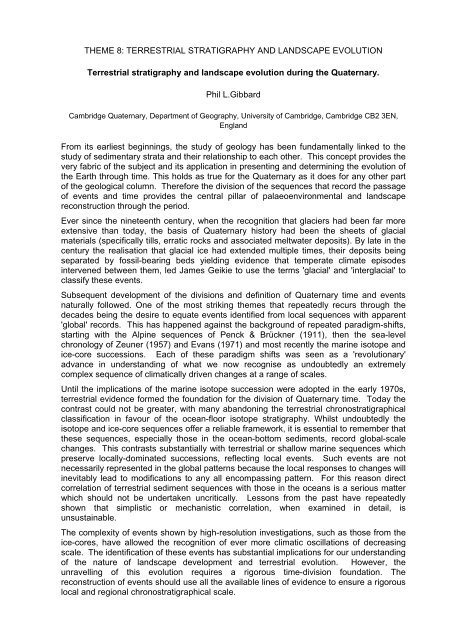The full programme book (PDF) - Royal Geographical Society
The full programme book (PDF) - Royal Geographical Society
The full programme book (PDF) - Royal Geographical Society
You also want an ePaper? Increase the reach of your titles
YUMPU automatically turns print PDFs into web optimized ePapers that Google loves.
THEME 8: TERRESTRIAL STRATIGRAPHY AND LANDSCAPE EVOLUTION<br />
Terrestrial stratigraphy and landscape evolution during the Quaternary.<br />
Phil L.Gibbard<br />
Cambridge Quaternary, Department of Geography, University of Cambridge, Cambridge CB2 3EN,<br />
England<br />
From its earliest beginnings, the study of geology has been fundamentally linked to the<br />
study of sedimentary strata and their relationship to each other. This concept provides the<br />
very fabric of the subject and its application in presenting and determining the evolution of<br />
the Earth through time. This holds as true for the Quaternary as it does for any other part<br />
of the geological column. <strong>The</strong>refore the division of the sequences that record the passage<br />
of events and time provides the central pillar of palaeoenvironmental and landscape<br />
reconstruction through the period.<br />
Ever since the nineteenth century, when the recognition that glaciers had been far more<br />
extensive than today, the basis of Quaternary history had been the sheets of glacial<br />
materials (specifically tills, erratic rocks and associated meltwater deposits). By late in the<br />
century the realisation that glacial ice had extended multiple times, their deposits being<br />
separated by fossil-bearing beds yielding evidence that temperate climate episodes<br />
intervened between them, led James Geikie to use the terms 'glacial' and 'interglacial' to<br />
classify these events.<br />
Subsequent development of the divisions and definition of Quaternary time and events<br />
naturally followed. One of the most striking themes that repeatedly recurs through the<br />
decades being the desire to equate events identified from local sequences with apparent<br />
'global' records. This has happened against the background of repeated paradigm-shifts,<br />
starting with the Alpine sequences of Penck & Brückner (1911), then the sea-level<br />
chronology of Zeuner (1957) and Evans (1971) and most recently the marine isotope and<br />
ice-core successions. Each of these paradigm shifts was seen as a 'revolutionary'<br />
advance in understanding of what we now recognise as undoubtedly an extremely<br />
complex sequence of climatically driven changes at a range of scales.<br />
Until the implications of the marine isotope succession were adopted in the early 1970s,<br />
terrestrial evidence formed the foundation for the division of Quaternary time. Today the<br />
contrast could not be greater, with many abandoning the terrestrial chronostratigraphical<br />
classification in favour of the ocean-floor isotope stratigraphy. Whilst undoubtedly the<br />
isotope and ice-core sequences offer a reliable framework, it is essential to remember that<br />
these sequences, especially those in the ocean-bottom sediments, record global-scale<br />
changes. This contrasts substantially with terrestrial or shallow marine sequences which<br />
preserve locally-dominated successions, reflecting local events. Such events are not<br />
necessarily represented in the global patterns because the local responses to changes will<br />
inevitably lead to modifications to any all encompassing pattern. For this reason direct<br />
correlation of terrestrial sediment sequences with those in the oceans is a serious matter<br />
which should not be undertaken uncritically. Lessons from the past have repeatedly<br />
shown that simplistic or mechanistic correlation, when examined in detail, is<br />
unsustainable.<br />
<strong>The</strong> complexity of events shown by high-resolution investigations, such as those from the<br />
ice-cores, have allowed the recognition of ever more climatic oscillations of decreasing<br />
scale. <strong>The</strong> identification of these events has substantial implications for our understanding<br />
of the nature of landscape development and terrestrial evolution. However, the<br />
unravelling of this evolution requires a rigorous time-division foundation. <strong>The</strong><br />
reconstruction of events should use all the available lines of evidence to ensure a rigorous<br />
local and regional chronostratigraphical scale.
















